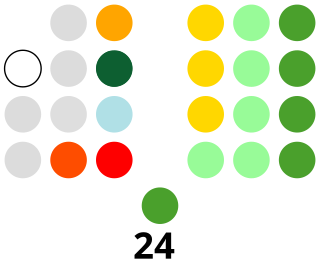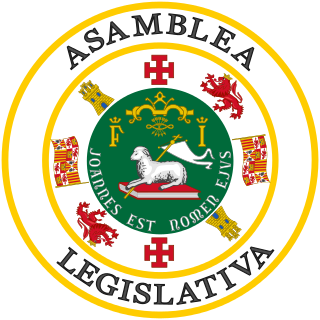Related Research Articles
Bicameralism is the practice of having a legislature divided into two separate assemblies, chambers, or houses, known as a bicameral legislature. Bicameralism is distinguished from unicameralism, in which all members deliberate and vote as a single group. As of 2015, about 40% of world's national legislatures are bicameral, and about 60% are unicameral.
In government, unicameralism is the practice of having a single legislative or parliamentary chamber. Thus, a unicameral parliament or unicameral legislature is a legislature which consists of one chamber or house.

The 30th United States Congress was a meeting of the legislative branch of the United States federal government, consisting of the United States Senate and the United States House of Representatives. It met in Washington, D.C. from March 4, 1847, to March 4, 1849, during the last two years of the administration of President James K. Polk. The apportionment of seats in the House of Representatives was based on the Sixth Census of the United States in 1840. The Senate had a Democratic majority, and the House had a Whig majority. It was the only Congress in which Abraham Lincoln served.

The Congress of the Philippines is the bicameral legislature of the Philippines. It is consisted of the Senate and the House of Representatives, although colloquially, the term "Congress" commonly refers to just the latter.

The Territory of Wisconsin was an organized incorporated territory of the United States that existed from July 3, 1836, until May 29, 1848, when an eastern portion of the territory was admitted to the Union as the State of Wisconsin. Belmont was initially chosen as the capital of the territory. In 1837, the territorial legislature met in Burlington, just north of the Skunk River on the Mississippi, which became part of the Iowa Territory in 1838. In that year, 1838, the territorial capital of Wisconsin was moved to Madison.

The Legislative Assembly of Puerto Rico is the territorial legislature of the Commonwealth of Puerto Rico, responsible for the legislative branch of the government of Puerto Rico. The Assembly is a bicameral legislature consisting of an upper house, the Senate normally composed by 27 senators, and the lower house, the House of Representatives normally composed by 51 representatives. Eleven members of each house are elected at-large rather than from a specific legislative district with all members being elected for a four-year term without term limits.

The Arizona State Legislature is the state legislature of the U.S. state of Arizona. It is a bicameral legislature that consists of a lower house, the House of Representatives, and an upper house, the Senate. Composed of 90 legislators, the state legislature meets in the Capitol Complex in the state capital of Phoenix, Arizona. Created by the Arizona Constitution upon statehood in 1912, the Arizona State Legislature met biennially until 1950. Today, they meet annually.

The Utah State Legislature is the state legislature of the U.S. state of Utah. It is a bicameral body, comprising the Utah House of Representatives, with 75 state representatives, and the Utah Senate, with 29 state senators. There are no term limits for either chamber.

First Capitol Historic Site is a free-admission historic museum located outside Belmont, Wisconsin, United States. The museum includes two of the buildings first used by legislators to meet in Wisconsin Territory. Currently owned and operated by the Wisconsin Historical Society, the site is listed on the National Register of Historic Places.

The Provisional Legislature of Oregon was the single-chamber legislative body of the Provisional Government of Oregon. It served the Oregon Country of the Pacific Northwest of North America from 1843 until early 1849 at a time when no country had sovereignty over the region. This democratically elected legislature became the Oregon Territorial Legislature when the territorial authorities arrived after the creation of the Oregon Territory by the United States in 1848. The body was first termed the Legislative Committee and later renamed the House of Representatives. Over the course of its six-year history the legislature passed laws, including taxation and liquor regulation, and created an army to deal with conflicts with Native Americans.

Oregon's Territorial Legislature was a bicameral legislative body created by the United States Congress in 1848 as the legislative branch of the government of the Oregon Territory. The upper chamber Council and lower chamber House of Representatives first met in July 1849; they served as the region's legislative body until Oregon became a state in February 1859, when they were replaced by the bicameral Oregon State Legislature.

The 1st Minnesota Territorial Legislature first convened on September 3, 1849. The 9 members of the Minnesota Territorial Council and the 18 members of the Minnesota House of Representatives were elected during the General Election of August 1, 1849.
The third Minnesota Territorial Legislature first convened on January 7, 1852. The 9 members of the Minnesota Territorial Council and the 18 members of the Minnesota House of Representatives were elected during the General Election of October 14, 1851.
The fourth Minnesota Territorial Legislature first convened on January 5, 1853. The 9 members of the Minnesota Territorial Council were elected during the General Election of October 14, 1851, and the 18 members of the Minnesota House of Representatives were elected during the General Election of October 12, 1852.
The fifth Minnesota Territorial Legislature first convened on January 4, 1854. The 9 members of the Minnesota Territorial Council and the 18 members of the Minnesota House of Representatives were elected during the General Election of October 12, 1853.
The sixth Minnesota Territorial Legislature first convened on January 3, 1855. The 9 members of the Minnesota Territorial Council were elected during the General Election of October 12, 1853, and the 18 members of the Minnesota House of Representatives were elected during the General Election of October 10, 1854.
The seventh Minnesota Territorial Legislature first convened on January 2, 1856. The 15 members of the Minnesota Territorial Council and the 38 members of the Minnesota House of Representatives were elected during the General Election of October 9, 1855.
The eighth Minnesota Territorial Legislature first convened on January 7, 1857. The 15 members of the Minnesota Territorial Council were elected during the General Election of October 9, 1855, and the 38 members of the Minnesota House of Representatives were elected during the General Election of October 14, 1856. The eighth territorial legislature was the final territorial legislature held before the Territory of Minnesota was dissolved and Minnesota was admitted as a state.

The second Minnesota Legislature first convened on December 7, 1859. The 37 members of the Minnesota Senate and the 80 members of the Minnesota House of Representatives were elected during the General Election of October 11, 1859.

The twelfth Minnesota Legislature first convened on January 4, 1870. The 11 members of the Minnesota Senate who represented even-numbered districts were chosen in the General Election of November 3, 1868, while the 11 members of the Minnesota Senate who represented odd-numbered districts, and the 47 members of the Minnesota House of Representatives, were chosen in the General Election of November 2, 1869.
References
- 1 2 "Sessions of the Minnesota State Legislature and the Minnesota Territorial Legislature, 1849-present". Minnesota Legislative Reference Library. Retrieved 9 November 2016.
- 1 2 3 "30th Cong. Sess. 2, Ch. 121, 9 Stat. 403-9" (PDF). Archived from the original (PDF) on 11 October 2015. Retrieved 9 November 2016.
- 1 2 "Number of Seats in the Minnesota Legislature". Minnesota Legislative Reference Library. Retrieved 9 November 2016.